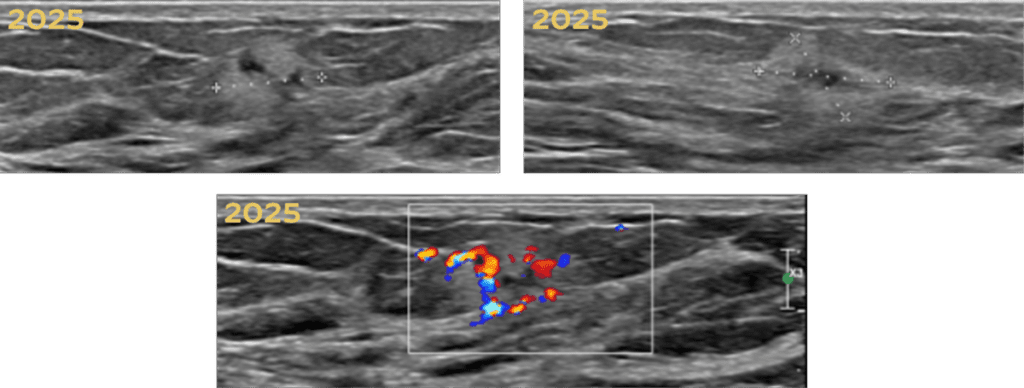The Radiology Partners (RP) Breast Imaging National Subspecialty Division (NSD) presents our newest Rad to Rad Learning case.
Peer Learning Opportunity
Hyperechogenicity is typically associated with benign breast lesions, including hamartoma, lipoma, angiolipoma, hemangioma, hematoma, fat necrosis, fibrosis, and galactocele. However, some rare malignant lesions may also appear hyperechoic.
Presents with palpable mass

Misdiagnosed as fat necrosis
Presents with new bruise

Misdiagnosed as hematoma
Hyperechoic Breast Lesions
Presents with persistent palpable concern
Biopsy-proven Invasive Lobular Carcinoma

Watch for subtle, suspicious features like irregular shape, non-circumscribed margins, non-parallel orientation, or posterior acoustic shadow.
Shared to improve patient safety and healthcare delivery in the provision of radiology services. The circumstances and facts are changed, altered, or deidentified to preserve confidentiality. Privileges have not been waived.
Practical Insights 
-
-
Don’t dismiss a lesion simply because it is hyperechoic. Correlate US findings with other modalities and the patient’s clinical history.
-
Consider specific histologies, not only invasive ductal or lobular carcinomas.
-
Rare cancers like angiosarcoma, lymphoma, and metastases can also present.
-
Don’t hesitate to recommend a biopsy for suspicious lesions. Do not rely solely on the hyperechoic appearance to rule out malignancy.
-
Contrast-enhanced mammography is a promising alternative for dense breasts.
-
 Hyperechoic breast lesions are not always benign.
Hyperechoic breast lesions are not always benign.
The Breast Imaging National Subspecialty Division (NSD) is part of RP’s Clinical Value Team, which works to elevate patient care and enhance value through innovation, collaboration and education. To advance this goal, our radiologists and advanced practice providers are committed to sharing peer learning as valuable reminders and insights about what we encounter in our day-to-day practice. Check back here and on X, LinkedIn and Instagram to see these common cases and our findings.
Visit the Clinical Resources page for more cases and to see what we’ve developed to enhance best practice recommendations, elevate image quality and patient care and update current standards throughout RP’s network of practices, all to deliver excellent radiology services to patients, referring clinicians and client partners.
Radiology Partners, through its owned and affiliated practices, is a leading physician-led and physician-owned technology-enabled radiology practice in the U.S. For the latest news from RP, follow us on X, LinkedIn, Instagram, YouTube and the blog.









